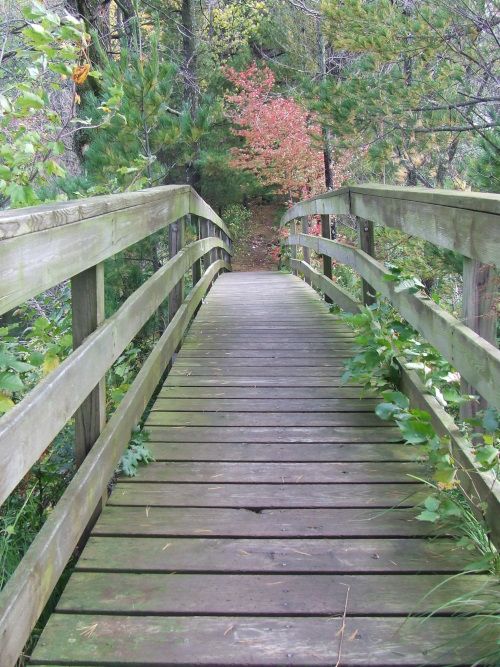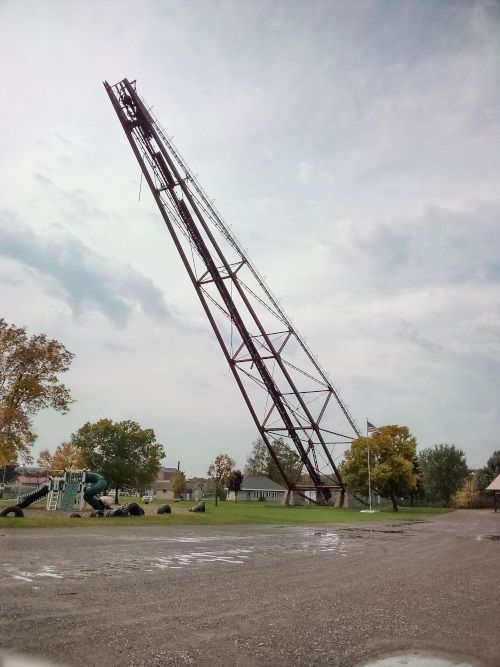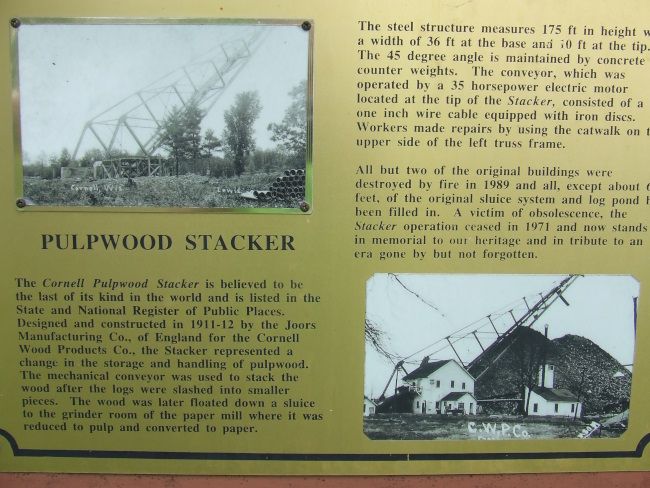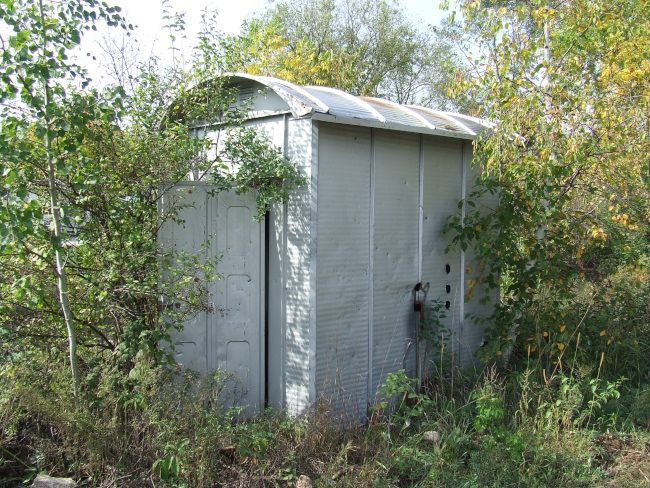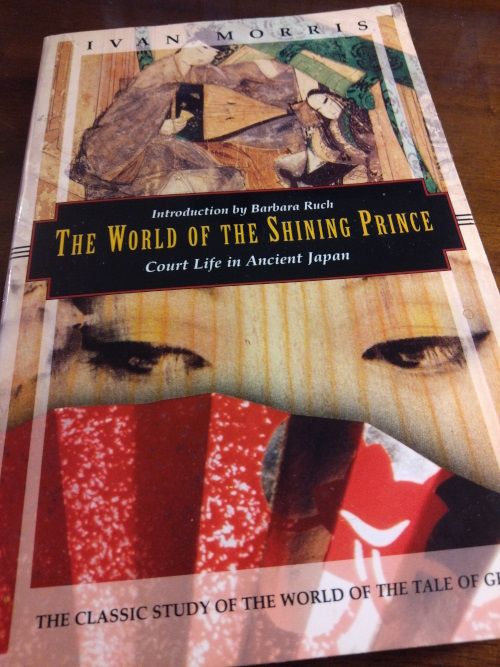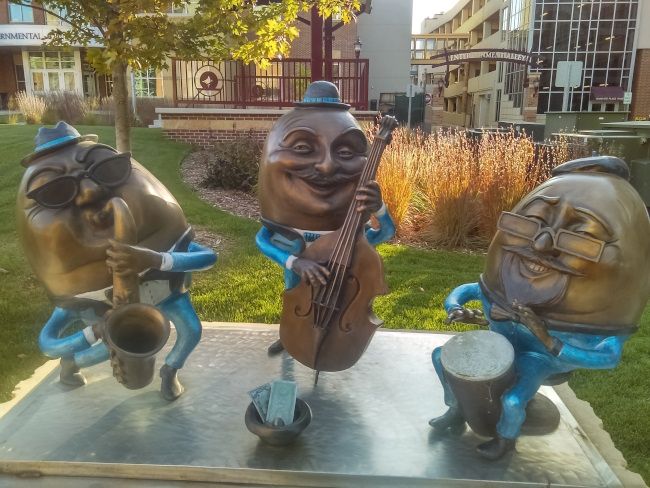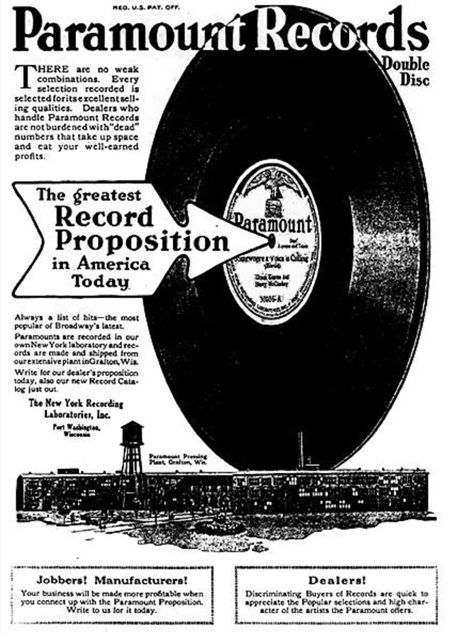(Read entry #114.)
25 July, 2024
24 July, 2024
The Corona Diaries Vol. 114: Getting cozy
(Listen to the accompanying sound track.)
(early October 2023)
Always a glutton for punishment, I returned to the Chippewa Moraine State Recreation Area the day after my spooky encounters. This time I glued myself to the familiar trails I have always hiked and have never once shared with a homicidal, axe-wielding maniac. To my knowledge, anyway.
While it was yet another overcast morning, there was no rain. The Circle Trail was, as always, simply gorgeous.
I again pondered how to plan a trip up here when there is more fall color. Perhaps senescence is creeping up on me but I would have sworn the Travel Wisconsin website I had consulted before driving north said that we were near peak color.
Not even close to peak, as I see it, but there were some great seasonal hues nonetheless. Just look at these red oak leaves!
As I do every year, I slowly traversed the trail, stopping at my whim. It’s such a relaxing place. Work seems a million miles away and my mind, lulled into a sense of ease by the quiet and solitude, wanders freely. It is nature's Calgon.
What's the point of going out into the woods if your goal is just to get back to the trailhead as quickly as you can? Why not just remain there and declare yourself the victor? I like stopping often to watch the woodland creatures scurrying about, to listen to the eloquent, rhythmic trills of birds and ponder what they're saying; to smell the earthy aroma of the land and trees; to feel the various textures of bark as well as the smooth yet tacky mushrooms that dot the trees; and to take lots of photographs because it takes me several shots to get one that’s in focus.
In that book I read a couple years ago about the benefits of being out in nature, The Nature Fix, the author noted that it doesn't take very long for salutary effects to take hold. Just 15 minutes can produce a noticeable reduction in stress. The more, the better, I say.
I rolled into town, which like last time, looked as if it was deserted like in a Twilight Zone episode. It was slightly eerie. At some point a car drove down the main drag to dispel the notion that Cornell had become the municipal version of the Mary Celeste but I saw no one on foot. Much to my disappointment, I discovered that the brewery was closed. Not permanently, just for the day. Oh well. Maybe they were short on help. As long as I was in Cornell, I thought I’d get some photos of the pulpwood stacker that I had neglected to get the last time I was in town.
The stacker, or what remains of it, anyway, is a giant steel structure that looks like an oil rig that leans at 45 degrees. The enormous arm of girders and cross beams looked to have weathered the decades well. Big concrete pillars anchored the leviathan.
As the name says, the Cornell Pulpwood Stacker stacked pulpwood. Here’s the historical marker.
You would have never caught me crawling up that thing to make repairs, I can tell you!
Today a figure appropriately carved from a log sits at the base to serve as a reminder of its former glory keep watch over the site.
Luckily they were receiving the thirsty and so I avoided having to cause a ruckus which would have probably seen the local constabulary throw me across the town line into a ditch. I began my treatment with, if I recall correctly, a lighter brew such as a golden ale or a cream ale but then for reasons I cannot explain, my typical desire for beer that tastes like beer deserted me and I got a s’mores porter or stout or whatever style it was. Such novelty beers are strictly verboten in my workaday life. I love the taste of grain and adore the flavors that are produced when they're cooked but, while on vacation, I occasionally throw caution to the wind.
The rim of the glass was lathered with marshmallow fluff that had a dusting of crushed graham cracker. I don’t know. Maybe I was still shaken by yesterday’s spooky walk and spectral encounter at Valkyrie and so my guard was down. Whatever the reason, this beer was a big mistake.
I think the beer itself was OK but I couldn’t really taste it after licking away some of that goop to get clear a spot that I could drink from. All that sweetness dulled my tongue to the (theoretically) succulent maltiness of the brew. I did not eat all of the marshmallow but the damage had been done by the little I did.
My next one was not the beer equivalent of a novelty ice cream treat but I could barely taste it. Heed this cautionary tale - avoid novelty beers!
Having eaten a moderately hearty lunch at the brewery, I needed to get out and about so I didn't descend into a post-prandial lethargy and decided to cruise around town to see what there was to be seen. One thing I saw was an ever rarer fallout shelter sign at the entrance to a church or a church school.
No doubt the older parishioners smile to themselves when the young folk look at it and ask just what the heck it is.
As I cruised down Main Street, I spied what appeared to be a Trachte shed off to the east. I turned down the next street and went in search of it. After a couple wrong turns, I finally found it in an industrial area that was bordered by train tracks.
I have no idea what it is/was used for but it was neat to see a little bit of Madison history up north.
When I went back to the hotel, I immediately showered and then sprawled out on the bed with the air conditioning turned up to high. With the sun beginning to set, it was time to bring out the book I was reading, The World of the Shining Prince: Court Life in Ancient Japan by Ivan Morris. It had been a long time coming.
I bought it back in circa 1999 in order to familiarize myself with the favorite era of Japanese history of the woman I was seeing at the time. She had been a Japanese language or Japanese literature or whatever other similar major the UW had on offer to aspiring nipponophiles. Her long hair and big eyes were captivating and her love of Japanese culture and history was quite alluring. It was impossible not to get taken in by the great enthusiasm and affection that emanated from her every word when she spoke about the early 11th century classic The Tale of Genji and its author Lady Murasaki. The Heian period, late 8th to late 12th century, was, as the kids say these days, her jam.
We dated very briefly and, although I had bought the book, I was unceremoniously dumped before I had dug in. With my main motivation of impressing a pretty lady now gone, I put reading the book onto the back burner as I pursued new frauleins. I never ran into another woman enamored of the Heian period and so the tome remained on my medieval history bookshelf collecting dust. One recent day as I was scanning my bookshelves looking for something to read, it occurred to me that I am getting to a point in my life where I really ought to start reading more books that I've meant to read over the years because, if I delay much longer, they'll go unread.
Published in 1964, The World of the Shining Prince is ostensibly for the layreader. But it has that academic sheen to it. I suppose this is still the time of The Great Books of the Western World where your average middle class Joe is presumed to be able to read Milton in its original early 17th century English and endowed with the ability to comprehend it without any helpful annotations.
Despite a fairly staid writing style, the book was quite interesting. The 2 centuries previous to the Heian period saw Japan appropriating any and everything it could from China much the way they pillage American culture today and come away with a profound love of baseball and Elvis. But as the 8th century became the 9th, the Japanese became more insular and began to generate their culture themselves rather than borrowing it from across the East China Sea.
As the title indicates, we’re talking about court life here, not the lives of the rural peasants. Chinese was still the language of choice in administrative, religious, and academic matters (like Latin was in the West during the Middle Ages) but Japanese became more common in literature during this time.
Buddhism came ashore and mixed with the native Shinto religion while the various superstitions that reigned such as directional taboos and a panoply of demons and ghouls were likely derived from older Japanese folklore.
At court, gentlemen were expected to be aesthetes of the highest order with a great sensitivity to beauty in art such as painting as well as more utilitarian things like gold inlaid boxes that held scrolls. Good calligraphy and the ability to compose verse was important for both men and women while courting. I cannot recall all of the details but the man would write a 31 syllable poem to the woman he was looking to get it on with. She’d reply and courtiers would fall over themselves to inspect her calligraphy to make sure it was up to snuff and everything was done in strict order. Quite a bit different and much more eloquent than a meager swipe to the right on a smartphone.
A very interesting book made all the more so by the fact that I knew precious little about the Japan of any time period going into it.
I woke up the next morning to find it rather muggy out and that the smoke from those Canadian wildfires had settled in overnight giving the town a hazy golden glow.
I got fuel – both coffee and gasoline – and cruised around town a bit more as I had a little time to kill for I had an appointment in Eau Claire at noon o’clock and the trip wouldn’t take me very long.
My youngest stepson had been shacking up with his girlfriend there until recently when she unceremoniously dumped him and kicked him out. He was now living with us in Madison and I had volunteered to stop by the apartment to fill my car up with as much stuff of his as it could fit.
I decided to wander the streets of Bloomer once more to see if I had missed anything yesterday and ran across a couple more items of interest. First was a restored ghost sign for the Hotel Anderson on Main Street.
Instead of taking Highway 53 all the way, I exited it before Eau Claire and took some backroads. I ended up at this intersection where county highway workers no doubt had a good laugh over a couple cigarettes and coffee when putting up the signs.
In Eau Claire, I stopped at a coffeehouse for more go juice and then at a dentist's office where some statuary had caught my eye back in August but a chance to take photographs eluded me.
Noon rolled around and I zipped over to the apartment. The kid’s ex-girlfriend was very kind and helpful. Much to my delight, I found that she had packed up his stuff and done so without seeming to have intentionally destroyed anything. She even helped haul some of the boxes to my car.
As I cruised down the road headed for home I was sad that my vacation was over. My hikes were simply wonderful and I enjoyed investigating Bloomer. But it was back to the workaday world and to being a stepdad to a very lost young man. I had to lend the kid support and try to convince him to rub some dirt on that wound and get back on that horse.
He is 24 and it’s all too easy for me to look back when I was at his age and sigh “Kids these days” in an exasperated tone. I was on the rebound too at that time of my life but I was gainfully employed and self-sufficient. Still, I have a lot of sympathy for him. He is welcome to stay with us. It’s fun to have him around. The kid has a long way to go and I’ll be there to help him. As they say, every journey begins with a single step and I am focused on getting him to take it.
********
Bonus photo. This time we have statuary from Mankato, Minnesota.
28 March, 2023
22 December, 2022
Ancient Infrastructure
Philip K. Dick maintained that the Roman Empire never ended. Well, it did. But they left behind quit a lot. Having taken Latin, I found this video (via Open Culture) to be really neat. It details some Roman roads and bridges that once can still use today. I'd love to walk on a Roman aqueduct or stroll along a stretch of the Via Appia.
19 March, 2016
The Mob Rules: Savage Continent by Keith Lowe
I suspect that many Americans think of the end of World War II as having been like this:
The boys came home, went to school on the G.I. Bill, and then got homes and jobs in the suburbs. While there is certainly some truth to this highly rosy scenario, the situation was much more complicated. American World War II veterans did have what we now call Post Traumatic Stress Disorder but it was most often something that was not talked about and men kept their feelings bottled up inside.
Many American vets certainly went through hell. But they came home to heaven, in contrast to the people of Europe. In Savage Continent, Keith Lowe examines the cimmerian world that was Europe in the years following the end of World War II. In his introduction he asks the 21st century reader to use her imagination and contemplate a world without social institutions; one where there are no stores and no businesses - money is worthless; a world without police, judges, jails, etc. No law and order. "There is no shame. There is no morality. There is only survival."
Lowe begins by looking at the physical destruction. Warsaw is his first example. It was a city of nearly 1.4 million people in 1939. By the war's end about two-thirds of those people were lost. Lowe says that the Germans systematically destroyed the city and, when they were through, 93% of Warsaw's dwellings were destroyed or left uninhabitable. Here are some photos.
Warsaw was but one of hundreds of cities to lay in ruins at the end of the war. Watch this remarkable footage of Berlin in July 1945:
Sensationelles Filmmaterial! Berlin nach der Apokalypse in Farbe und HD - Berlin In July 1945 (HD 1080p) from Konstantin von zur Mühlen on Vimeo.
Beyond the destruction of buildings, there was the toll on human life. Some 35-40 million people died as a direct result of the war with some 6 million of those being Jews. Lowe concedes the difficulty in appreciating such vast numbers and so he includes the words of survivors to put the numbers into a more manageable perspective. For instance, there is the testimony of Alice Adams originally from Drohobycz, Poland. "...the whole population of Drohobycz was wiped out, about thirty thousand people, they were all shot...I watched somebody being killed every day – that was part of my childhood."
Europe was awash with widows and, with many children having lost at least one parent, kids were often found in packs wandering the streets like feral dogs. Hunger was rampant. Some 16,000-20,000 Dutch died of starvation while that number jumps to a quarter of a million in Greece. But Eastern Europe had it worst. Indeed, it seems that almost every infernal scheme the Nazis had was worse for Slavs. Much of the hunger in Western Europe was the result of Hitler simply giving preference to Germans, but in the East the Nazis were keen on starving Slavs to death out of spite and millions died.
Lowe devotes roughly a quarter of his book to vengeance. In countries throughout Europe people who collaborated with the Nazis were punished. Some were merely made to suffer opprobrium while others were given minor punishments such as the loss of voting rights. But harsher punishments were handed out both by reconstituted courts and by extrajudicial justice seekers. Collaborators were sometimes given the death penalty by judges while vigilantes meted out justice in the form of beatings and murder. And of course Germans were at the receiving end of the vengeful as well. For example, Allied soldiers often looked the other way so that concentration camp survivors could take revenge on their former jailers. Unsurprisingly, just being German was enough to incur someone's wrath. Innocent German civilians were often shown little mercy by their former neighbors and none whatsoever by the Russians moving ever westward.
Women from occupied countries who had consorted with Germans suffered at the hands of their own people. I was reminded of the tragic story of Izabel Laxamana, a 13 year-old girls who killed herself after her father punished her by cutting off most of her hair. Amanda Hess denounced the punishment as being "medieval" over at Slate. But as Lowe shows, women from all parts of Europe who had relationships with members of occupying German forces had their heads shaved. Often times this was done in a town square or other public space where the women were stripped naked (by men, of course) and had swastikas painted on them in addition to being shorn. Children from these unions were frequently shunned and written off as being evil Germans despite their mothers' heritage.
The sheer destruction of life and property was depressing. Add on to that the petty acts of vengeance and the situation is even more bleak. But it was really the book's third section on ethnic cleansing that almost sent me into the depths of perdition.
Since the concentration camps were located in eastern Europe, many people in the west were unaware of just what had happened. Jews returning home to Holland were often greeted with such sentiments as "You're lucky you weren't here. We suffered such hunger!" and "You have a roof over your head and food the whole time!"
But insensitivity was the least of all worries. Having survived the Holocaust, European Jews found that their tribulations were not yet over. The section called "The Jewish Flight" tells the tale of a Polish Jew named Roman Halter. He survived the death camps and was liberated by the Russians. On his trek back to Poland to search for his family, Halter encounters a Russian soldier who treats him no better than the Germans. The soldier "took out his revolver from his holster, pointed at my head and pulled the trigger. There was a loud click."
Jews returning to their homes often encountered resistance when trying to reclaim their property. The book has one of the darkest examples of black humor in the form of a joke. A Jew returns home to Budapest having survived the Holocaust. He encounters a Christian friend who asks how he's doing. The Jew replies, "Don't even ask. I have returned from the camp and now I have nothing except the clothes you are wearing."
In Kunmadaras, Hungary, tensions and anti-Semitism came to head when blood libel was invoked to attack an egg vendor. A mob would go on to surround the man's house and kill him before seeking vengeance on other Jews in a mini-pogrom.
Polish-Ukrainian hatred gets a section of its own. With German power declining, Ukrainians took to partisan groups such as the Ukrainian Insurgent Army and set out against Poles. In 1943-44 hundreds of Polish villages were beset by the thirst blood of such groups. Buildings were burned and some villages razed entirely while victims were beheaded and/or disemboweled.
The tables turned after the war illustrated by the fate of a village in Poland called Zawadka Morochowska which was inhabited by Ukrainians. The Polish army arrived in January 1946 and began a massacre. Dozens of villagers were murdered with some having been disemboweled or set on fire.
You get the picture.
Savage Continent does a remarkable job of describing the pandemonium of post-war Europe. Going in I tended to think of the time following the German surrender as being filled with people wandering urban ruins, the Marshall Plan, and the raising of the Iron Curtain. Upon finishing the book I felt a bit numb contemplating what the darker sides of our nature can accomplish. Lowe writes for the layreader here and the text includes plenty of photos portraying the chaos and destruction in graphic detail.
Lowe sets for himself some goals in the book's introduction. As a non-historian who has never read anything on this subject previously, I really don't know about the paucity of histories of the immediate postwar period and how Savage Continent fits into the larger study of this time. But he accomplished his goal of dedicating an ample number of pages to eastern Europe instead of focusing on the western half as, he says, most scholarship on the subject does. Lowe also mentions that he attempted to sort through the varying statistics in an even-handed manner. There are multiple times in the book in which he weighs differing stats and I felt he adjudicated fairly.
While I learned quite a bit from Savage Continent, there was one section which came across as pop psychology to me. In "The Shearing of Women", Lowe claims that "On the whole, European women slept with Germans not because they were forced to, or because their own men were absent, or because they needed money or food – but simply because they found the strong, 'knightly' image of the German soldiers intensely attractive". He proceeds to opine that French men were emasculated by the Germans and that they really began to shed the effeminate taint as the French and the Allies set out to liberate France. While I'd have to check out Lowe's source materials (and this book is well-researched), this section stood out for me because it felt like it had left history and statistics behind for baseless Freudian theorizing.
Lowe ends the book with a plea for truth and historical accuracy to prevail over falsehoods and national mythmaking, things which divide and can be used to incite hatred or worse. It was refreshing to read an historian talk about and give examples to illustrate why his profession and his area of study are important and what they can give to non-historians. Lowe writes, "It is not our remembering the sins of the past that provokes hatred, but the way in which we remember them."
There is much to chew on here. Not only does it help explain how the Europe of today arose, but it also makes you ponder the future. For example, can ethnic hatreds that abated after the end of the Cold War reemerge? What can a fuller understanding of history do for us?
25 February, 2016
Porch, you magnificent bastard - I read your book! (The Path to Victory by Douglas Porch)
World War II was a big deal in my house when I was a boy. My father was a voracious reader and he had a small library devoted to the subject. People like Chester Nimitz and George Patton were talked about as if they were great uncles. He had a particularly keen interest in the Pacific Theater and was always interested in meeting veterans of that part of the war. When he did, most did not want to talk about their experiences in places like Iwo Jima or Okinawa. But on he pushed.
It is no surprise that his interest rubbed off on his sons. While in elementary school I wrote a paper on the attack on Pearl Harbor. While I've always had more than a passing interest in the history of World War II it was really my brother who shared my father's passion on the subject. When our father died I was happy to let him keep all of dad's books on it. My brother became one of those WWII history nerds who could tell you exactly how many casualties there were at a given battle and recite a list of every model fighter plane Messerschmitt built and the precise date they were introduced into combat.
When my brother died last year I felt that the family legacy of interest in and knowledge of World War II only had me to carry it on. And so I decided to do some reading on the topic. However, I didn't just want to sit down and read something like Samuel E. Morison's multi-volume History of United States Naval Operations in World War II, a favorite of my father's. No. If I was not able to deny the ghosts of my father and brother then I at least would have to tack a course of my own devising. (To be expected, I suppose, since I had already tackled The Rape of Nanking by Iris Chang.)
Douglas Porch's The Path to Victory was not my first foray into the subject of WWII after my brother's death but it's the first I've written owing to circumstance. The subtitle of the book is "The Mediterranean Theater in World War II". While the Mediterranean was certainly spoken of in our house, it did not have the cachet of the campaign to take the Solomon Islands or the Battle of the Bulge, for example. And in American culture today it is over-shadowed by the Ambrosian-approved D-Day landings. A perfectly suitable subject for me.
A military historian, Douglas Porch, the back cover tells us, "is a professor of national security affairs at the Naval Postgraduate School". The book's text is just shy of 700 pages with another 100 or so of notes, index, and whatnot. This is not a slim introductory volume. Indeed, the book is not aimed at your average lay reader but at students of military history although I would say that interested people – like me – along with the Internet can get through it with good comprehension.
The book's thesis is that the Mediterranean was the pivotal theater in the war though not the decisive one. Events in this theater prefaced, influenced, aided, and abetted the more conclusive ones in theaters to the north. Not being a military historian, I am unqualified to judge the success or failure of Porch's argument. Instead I want to highlight some elements of Porch's story that caught my attention. Some directly relate to Porch's thesis while others do not.
One thing I found interesting was that Porch has a wide view of what constitutes the Mediterranean Theater. He included Eritrea/Ethiopia as well as the greater Middle East. While Italy controlled East Africa, FDR could not send aid through the Red Sea as he was not allowed to put American ships into combat zones. Once Britain had cleared the Horn of Africa of Italian forces, U.S. ships were free to sail the Red Sea and onwards towards Suez.
One significance of the Middle East was, unsurprisingly, oil. Gasoline was rarely in short supply for Allied troops in North Africa while it was so very often for the Germans and Italians whose oil came from across the Mediterranean in Romania. I was unaware that Britain invaded Iraq in April 1941. In addition to preventing German intervention in the region, it would "showcase its [Britain's] value as an ally for the United States." Indeed, Churchill and the British army did a lot of the equivalent of a peacock displaying his tail feathers to get the attention of the United States and lure it into the war. Rommel running roughshod around North Africa was an embarrassment to the British, not only from a purely operational point of view, but also a strategic one. It made Britain look bad and perhaps not like a worthy ally for Americans watching from across the Atlantic.
North Africa is generally thought of as the first act of the Mediterranean Theater. While I knew about the dramatic and perhaps romanticized duel between Rommel and Montgomery in supra-Saharan Africa, it was interesting to get the details of their encounters. It was also interesting just how awful Montgomery's predecessors were. They used the same losing strategy over and over again – charging head on into the ranks of Rommel's panzer tanks which demolished the British foes. Montgomery's victory over Rommel at El Alamein was due in no small part to letting artillery and air support get first crack at the panzers which then drove forth into an arena populated with British tanks and anti-tank guns dug into the desert and lying in wait for their prey.
North Africa is also where American soldiers made their debut in the West and it was not exactly pretty. Operation Torch was the Allied invasion of Algeria and Morocco. While thankful for being joined in the war, battle-hardened British soldiers were less than impressed with the green G.I.s. Porch says that "Infantry attacks often became murderous undertakings". He also notes "poor infantry-armor cooperation", American tanks that "charge[d] off unsupported on their own, and commanders "reluctant to seize battlefield opportunities."
Although I probably shouldn't have been, I was surprised at all of the animosity amongst the ranks of upper command. Not only between Americans and British, but amongst the Americans and amongst the British. Take the British Lieutenant General Kenneth Anderson. Montgomery described him as being "neither skilled nor gifted" while Patton thought that he "seems earnest but dumb".
With the efforts of Stephen Ambrose, Tom Brokaw, Steven Spielberg, and the media generally to portray America's "Greatest Generation" as having won the war with the D-Day invasion, it was thrillingly refreshing to read a much less romanticized account of some Americans and American efforts in WWII. As Commander-in-Chief of Allied Expeditionary Forces Dwight Eisenhower is described by Porch as having a "natural reluctance to make hard decisions." Then there's U.S. Army Major General Lloyd Fredendall who shuffled papers bravely out of range and chose to "disparage 'Jews, Negroes, and the British' from his concrete-encased bunker well to the rear."
And these comments are just the tip of the iceberg. Sometimes I found myself amazed that we and the British managed to fight a common enemy.
Operation Husky was the name of the Allied invasion of Sicily and is usually thought of as being Act 2. While the Allies took the island, the thing I recall most vividly is that they let the Germans successfully retreat to Italy. Porch puts the Allied inability to prevent this down to "poor organization, lack of imagination, and inactivity."
This is probably as good a point as any to declare that I didn't know that Mussolini was such an incompetent boob. The guy would not listen to his generals and ignored the reality on the battlefields. I felt sorry for the Italian troops most of whom were ill-equipped and undertrained with Il Duce telling them to fight or be killed for cowardice.
One upshot of Mussolini's numbskullery, which forms part of Porch's thesis, is that it obligated Hitler to send troops and supplies to do what the Italians were incapable of doing. Hitler worried about Italy and the Balkans – his southern flank – and he dedicated many divisions along with tanks and air power to the Mediterranean Theater and away from Russia. For quite some time the only battles being fought between the Allies and the Germans were in the Mediterranean. They helped instill confidence in Stalin that the Allies were attempting to help the Soviets. The Allies feared that Stalin would make peace with Hitler depriving them of a very big and powerful ally which kept many German soldiers occupied in Eastern Europe.
With the Germans expelled from Sicily, shipping became much safer in the Mediterranean which meant that many more American supplies reached the Soviet Union. And as the Axis were increasing pushed back, Hitler diverted air power from Norway south to take on the encroaching Allies. This meant Arctic convoys had a much easier time getting supplies to Murmansk.
The generally perceived final act of the Mediterranean Theater is the invasion of Italy. Again, Porch proved quite enlightening. Monte Cassino, Anzio - I'd heard of these places but here I got all the gory details. Yet again I must admit to ignorance – I didn't know what a long, hard slog Italy was for the Allies. Field Marshall Albert Kesselring and (who had been allowed by Allied bungling to escape Sicily) his German troops put up heinous resistance. The worst fighting of the whole theater seemed to have been in Italy.
Aside from the particularly hellish campaign that was the invasion of Italy, three things stick out for me. First is the contribution of Moroccans in defeating the Germans. The Germans took advantage of the mountains and create defensive lines with bunkers high up making the valleys into kill boxes. It was the Moroccans who proved adept at scaling the heights and taking out German installations. As Porch says, "German POWs were so intimidated by the bunker-busting techniques of the Moslems that they declared the experience worse than Stalingrad."
On a tangential note, Porch mentions more groups of valorous non-white combatants – the Fourth and Seventh Indian Divisions (OK, not wholly non-white) - which "were considered among the best troops fielded by any army in the war."
The other thing that sticks in my mind about the invasion of Italy is the behavior of Lieutenant General Mark Clark. In May of 1944 the Allies launched Operation Diadem which saw opposed by the German Tenth Army. Clark put his quest for personal glory above Diadem's strategy by focusing on taking Rome – which would be a publicity coup – instead of defeating the Germans. Porch says, "...he both allowed the escape of the Tenth Army and did nothing to advance the capture of Rome, while at the same time taking heavy casualties."
Lastly, Porch notes that VD ran rampant amongst Allied soldiers in Italy. May Italian women (and girls) were eager to please for food or money and by the summer of 1944 there were 19 VD hospitals in Italy to help cure the Greatest Generation.
I think that Porch would agree that North Africa, Sicily, and Italy are the three main elements of the Mediterranean Theater but that there was much more to the theater than these three campaigns. In addition to what I've already mentioned, there was Operation Dragoon, the Allied invasion of southern France in August 1944. And the general rehabilitation of France as a fighting ally.
To reiterate Porch's point, the Mediterranean Theater was the handmaiden to decisive campaigns of the war. It forced Hitler to commit troops, tanks, and planes which had to be taken from other areas, most notably the eastern front. Significant amounts of American supplies were able to reach the Soviet Union only by virtue of the Allied success in the Mediterranean. And it was this theater in which American commanders and soldiers cut their teeth and learned their trade. Porch argues they needed the training and practice of the Mediterranean to be ready for the invasion of France on D-Day.
As I mentioned at the beginning, The Path to Victory is not really aimed at those starting out on the subject. It's more for students of military history. One example illustrating this is that Porch compares a situation to that of the Battle of Passchendaele during World War I. If World War I is not your strong point, then you'll be running to the Internet to assess Porch's comparison. Porch also has a penchant for French phrases which may send the reader to a dictionary. Beyond these things, Porch writes clearly and presents his material in a linear fashion.
The book looks at the big picture. By this I mean that it was written in a fairly traditional style whereby the generals are personalized with brief biographies given while the grunts, the G.I.s are generally generic people who are parts of larger units moved around by the generals. Occasionally, however, Porch does get down to the grunt level to illustrate a point. I say this not to disparage Porch because the text of the book is almost 700 pages and his goal was to present a broad view of an aspect of the war generally given short shrift. Porch has no problem presenting commanders in a less than flattering light while, as I noted above, lavishing praise on non-white soldiers, people often left out of lay histories of the conflict.
I have barely scratched the surface of what Porch brings to the table here. The book ranges from really fun passages about larger than life characters such as George Patton to fairly dense, theoretical sections dealing with strategy. It's not just this battle happened on this date and this many men died. We get glimpses into Hitler's view from the north as well as the struggle between Churchill's desire to preserve the Empire and FDR's ambition for the United States. Porch has a lot of balls in the air here and he juggles them well. You get just enough of peripheral issues and events to see how they fit in the Mediterranean Theater without ever going off into left field.
I do, however, have a complaint to register. My copy of the book was the American first edition paperback and the maps were of such poor quality as to be useless. By this I mean the print quality. It was like they started with maps that were originally 1"x1" and then blew them up for the book. Most of the words on the maps are tiny, pixelated, and illegible. This didn't render the book useless but a lot of the battles and the events Porch described blur together because, unless you find similar maps from another source, you're never quite sure which division went where and what road who is on and what the overall look of a campaign was.
My admonitions and criticisms aside, I highly recommend The Path to Victory. I only wish that I could talk it over with my brother and father.
30 March, 2015
First U.S. Penny Was Godless and Instead Promoted Science
The coin, known as the "Birch Cent," was made in 1792, months after the one-cent denomination was first authorized by Congress, according to the auction house Stack's Bowers Galleries.
It was made in a trial run for the penny, and depicts Lady Liberty. Thomas Jefferson and George Washington discussed the design in letters dated August 1792, before it was presented to Congress as an option for the new coin.
The article makes it sound like this was merely a prototype coin and not legal tender. Having now looked at Wikipedia it would seem that this coin lost out to the Chain cent as the first penny used as legal tender in the United States. The profile of Lady Liberty was retained for the front of the Chain cent.
While the Chain cent merely says "Liberty" on the front, the Birch cent says "Liberty Parent of Science & Industry". For all the bluster of charlatans such as David Barton about the United States supposedly being a Christian nation, "In God We Trust" was not placed on American currency until 1864. And here we can see the privileging of science over religion in the very early days of our republic.
06 October, 2014
Those Poor Navarrese
Well, Maher's got nothing on the medieval author of The Pilgrim's Guide to Santiago de Compostela. I've been reading about medieval Iberia and the book includes some excerpts from this work which was written around 1140. As the title indicates, it's a guide for people making a pilgrimage to Santiago de Compostela in northwestern Spain. According to the text, it was nearly as popular a destination for pilgrims as Rome or The Holy Land which makes one wonder why there's this myth that medieval folks didn't travel far from their homes.
The author is an anonymous Frenchman who informs travelers of which rivers are safe to drink, what towns are to be found on the route, and about the natives as well. Whoever the author is, he really didn't like the Navarrese. (Navarre is or was a region in north-central Spain.) I mean he really, really didn't like the Navarrese. He begins by noting that "These people, in truth, are repulsively dressed and they eat and drink repulsively." It gets worse.
...when the Navarrese are warming themselves, a man will show a woman and woman a man their private parts. The Navarrese even practice unchaste fornication with animals...He even offers libidinous kisses to the vulva of woman and mule.
A Frenchman decrying oral sex?! Forsooth! Up to this point in the book, at least, not even the Jews are described so harshly. Sure, they are said to be greedy and untrustworthy but at least they didn't practice cunnilingus.
Oh, but here's the best bit:
This is a barbarous race unlike all other races in customs and in character, full of malice, swarthy in color, evil of face, depraved, perverse, perfidious, empty of faith and corrupt, libidinous, drunken, experienced in all violence, ferocious and wild, dishonest and reprobate, impious and harsh, cruel and contentious, unversed in anything good, well-trained in all vices and iniquities, like the Geats and Saracens in malice, in everything inimical to our French people.
The author does concede that the Navarrese are good warriors on the battlefield so they're not all bad.
07 March, 2014
Rocket cat, burning out its fuse up there alone
You're a 16th century German prince plotting to crush a peasant rebellion, or perhaps you're leading an army against the Ottoman Empire or looking to settle the score with a rival nobleman. What's a guy looking for a tactical edge to do?
Bring on the rocket cats!
Fanciful illustrations from a circa-1530 manual on artillery and siege warfare seem to show jet packs strapped to the backs of cats and doves, with the German-language text helpfully advising military commanders to use them to "set fire to a castle or city which you can't get at otherwise."
"Create a small sack like a fire-arrow .Iif you would like to get at a town or castle, seek to obtain a cat from that place. And bind the sack to the back of the cat, ignite it, let it glow well and thereafter let the cat go, so it runs to the nearest castle or town, and out of fear it thinks to hide itself where it ends up in barn hay or straw it will be ignited."
Sounds pretty ridiculous but according to Wikipedia, the Russians used anti-tank dogs in World War II and the U.S. military even trained some of their own.
27 November, 2013
Hoary-Haired Warriors and Clean Venus Chambers: Medieval Culture and Society - David Herlihy, ed.
I have to admit to being a bit leery when I bought this book. Having been published in 1968 I was concerned that new evidence had been uncovered in the past 45 years which would contradict or at least cast new light on some of the themes presented in it. Plus the field itself has no doubt changed over the years. From my experience, older texts on medieval history tend to ignore women and pretty much anyone who wasn't clergy, royalty, or aristocracy while newer ones often fill in these gaps. Books laying out who ruled and went to war when are easy to come by but ones that give me a sense of a medieval mindset and vivid descriptions of quotidian life are harder to find. But this book was cheap so I wasn't going to lose much if it turned out not to hold anything new for me. As a bonus, I discovered halfway through that the editor, David Herlihy, was a professor here at the UW-Madison when this book was published.
The book is divided into three parts that each cover the generally accepted eras of what we call the Middle Ages. You've got the Early Middle Ages which spans roughly from 500C.E. to 1000.; then there's the Middle Middle Ages which lasts until 1350; and finally the Late Middle Ages which goes until 1500. Each of these sections includes primary sources, texts in whole or excerpted, from the respective periods with each having a short introduction by Herlihy. There is a good mix of texts here. You've got histories, papal writings, poems, saintly hagiographies, etc. But you also get various government documents spawned by medieval bureaucracies.
The book begins with Tacitus giving us an overview of Germanic culture in the first century C.E. I was pleased to find out that my ancestors were a fun-loving bunch: "No other race indulges more freely in entertainments and hospitality." It came as absolutely no surprise to me to read that they drank beer. "A liquor for drinking bearing a certain resemblance to wine is made by the process of fermentation from barley or other grain." Speaking of beer, we also have De Villis, a manual for running royal estates thought to be issued by Charlemagne himself, in which we find "During the time the steward performs his service, he should have his malt delivered to the palace. Similarly, let masters come who know how to make good beer there."
Having read a fair amount about St. Benedict and Benedictine monasteries, I was happy to actually find something from the man himself here, namely, the Rules of St. Benedict, from c. 540 in which he lays out monastic virtues. Unlike the monks featured in Into Great Silence who enjoy sledding from time to time, it would seem that Benedictine monks would have been a very dour, humorless group. What are the "instruments of good works"? Not to embrace pleasure. To be terrified of hell. To hate one's own will. Not to pronounce idle or frivolous words. Just imagine Jorge de Burgos as your boss. Uff da!
Also included is a description of the Synod of Whitby by Bede the Venerable. The Synod took place in 663ish and featured the English and the Irish churches arguing over when to place Easter. The English want to adopt the practices of the Church in Rome whereas the Celts were keen on their own dating tradition. A bishop named Wilfrid argued for following Rome's example and did so in only the most confusing way possible. To wit: "But if the Sunday were not to come the next morrow after the 14th day of the change of the moon, but the 16th or 17th or any other day of the moon until the one-and-twentieth, he tarried for that Sunday, and the Sabbath before, upon the evening, he began the most holy solemnity of Easter." Whew! No doubt early Church fathers would be appalled at how Christmas has taken the top spot in the ranks of Christian holidays.
When we get to the Middle Middle Ages, historians have a much larger written record to draw from and, consequently, this section of the book is much lengthier than the first.
Much is made of the feudal system but cities and towns were often granted special rights and privileges in the name of promoting commerce. An example is given here in form of the statutes of the "free village" of Lorris in France. In the early 12th century land was cleared and, in order to get people to settle in the new village, liberal regulations were adopted by Louis VI. We're not talking a libertarian paradise here but various fines, tolls, and taxes were waived. And men didn't have to leave town in order to take a case to court.
Even an unschooled layreader like myself can't avoid the great love story of Abelard and Heloise. As with St. Benedict above, it is nice to read about their legendary love story first-hand instead of third. Abelard was a renowned philosopher who became smitten with Heloise. She lived with her uncle so the crafty scholar installed himself in the uncle's house and began a relationship with Heloise. In short, she gets pregnant and, when the matter becomes public, he is castrated. Here's how he describes the terrible act: "For they cut off those parts of my body, by which I had committed the deed which sorrowed them." That's putting it lightly.
This period is one in which literature flowered. Instead of fiction devoted entirely to the derring do of warriors on the battlefield or the hunt for Grendel, we have Dante's epic Divine Comedy, the humorous tales of sly and cunning Reynard the Fox, and lyric poetry devoted to love. Of the last we have an excerpt from Romance of the Rose. Today we complain about George Lucas tweaking his own movies with CGI, but imagine being a fan of this poem which was hastily completed after the author died and then expanded four fold a few decades later. The original tale by Guillaume de Lorris was written around 1237 but he did not complete it. To de Lorris' 4000 lines were added 78 new ones by an anonymous author so that the story concluded. Cut to 1277 when Jean de Meun re-wrote the ending. This seems heretical enough to us but, to make matters worse, he took his sweet time and added 16,000+ lines to the original. De Lorris wrote about a man seeking love, "aided in his quest by mirth, courtesy, gladness, wealth, largesse, and other qualities". The special extended addition is more vulgar as we find here with excerpts from passages by both authors.
De Lorris describes how a man may be courteous and attract women with his good manners. "Be courteous and accommodating/With soft and reasonable words," he writes. Also "When you are passing through the streets/Be sure you act politely." This is the stuff parents teach their children. However, de Meun takes another route and describes the advice from an old nurse given to women who wish to succeed in love. One handy bit of advice: "She should keep her Venus' chamber clean/If she is refined and well brought up/Let her leave no spiderwebs about". De Meun is like a proto-editor of Cosmopolitan magazine here.
The section dealing with the Late Middle Ages is the shortest of the three. You've got Boccaccio describing the Black Death in Florence and some Chaucer as well. "The Ordinance of Laborers" by Edward III interested me. In the wake of The Plague, workers were in short supply and so could demand higher wages and have more choice in where they plied their trades. Edward, apparently not a fan of the law of supply and demand, took matters into his own hands and dictated terms for workers in his lands. It became forbidden for reapers and mowers to "depart from the said service without reasonable cause or license". "Artificers and workmen" saw their pay limited to pre-Plague rates. Perhaps in a blow for consumer rights, Edward also commanded that "sellers of all manner of victuals" sell their food "for a reasonable price".
Judging from the preface, Medieval Culture and Society is a text for the layreader like myself. (One also learns in the preface that Herlihy was a professor here at the UW-Madison when he compiled the book.) And the introductory material is also clearly written for someone, also like me, who is not fully steeped in medieval history. One problem is that these elements are very concise and people just learning the subject are probably going to be left with many questions. This book is not largely an historian explaining history and then giving examples from primary sources to illustrate his text. Instead the reader is given brief outlines as introductions and then thrown in the water to sink or swim. While by no means a scholarly book, this is also not meant for readers who are just starting with the subject.
Along these same lines, there are times when footnotes would have been handy. Take "So Filled With Happiness" from the section about troubadour lyric poetry. It has the line "Richer than gold in Frisian mart". How many modern average Joe's are going to A) know where Frisia is and B) understand why the author would have referred to it?
At least this is better than the Great Books of the Western World series for which editor Mortimer Adler decided against introductory notes completely. One thing Great Books and Medieval Culture and Society have in common is a love for translations that aren't much newer than the texts they transcribe.
Take, for example, Song of Hildebrand. It is littered with thee's and thy's. Plus you've got "Canst win the harness from so hoary a man". It's better than the Old High German of the original but had no one translated it after 1650? I'm no scholar so I don't know exactly who has translated what and when, but you'd think that the core texts, texts that form the foundation of our understanding of the time, would have at least semi-modern translations.
The Internet mitigated some of these problems and it also helped that I was not starting from scratch when it came to medieval history. Overall, Medieval Culture and Society was good reading. I especially enjoyed being able to read the words of figures I've only read about. But a lot was left out. For instance, there was nothing written by women here – not even a token entry from Hildegard of Bingen. Maps are always welcome too. Help me place the events described, where they are on the globe but also where they are located politically. What are the boundaries of the kingdom? The more context the merrier, I say.
23 October, 2013
Another Side of World War II: The Rape of Nanking by Iris Chang
Having read Iris Chang's The Chinese in America and found it quite engaging and enlightening, I was happy to find another of her books, The Rape of Nanking.
I was a bit perturbed while reading the introduction when I ran across this: “Yet the Rape of Nanking remains an obscure incident.” Chang goes on to list various well-known histories of World War II which mention the Japanese atrocities in Nanking only in passing, if at all. Having had a father who was a WWII history buff, I knew about the Rape of Nanking, so I am at somewhat of an advantage over many people regarding the conflict. Still, one would think the sheer cruelty on display those several weeks would have taken their place alongside other infamous acts of barbarity from the war.
The book addresses two broad aspects to the topic at hand. The first is a prelude to and then the Rape itself along with a diversion into the Japanese mentality that led to it. After this, Chang looks at the event as viewed from outside Asia as well as the aftermath on personal and geopolitical levels.
In July of 1937 Japanese troops stationed in the Chinese city of Tientsin took gunfire one night while training near the Marco Polo Bridge. The next morning of the soldiers was missing from roll call. This incident escalated and led to a full-scale invasion of China. Thus began the Second Sino-Japanese War. The battle for Shanghai lasted a few months before the Japanese ultimately retained control in November. From there the armies marched to Nanking, the capital of the Republic of China and home to 1+ million people. With the Japanese advancing, many fled the city but there were still some 600,000-700,000 people there when the Japanese assault started on 9 December. By the 13th, Nanking had fallen and the unthinkable began.
What the Japanese did to the people in Nanking would have made Genghis Khan proud. Prisoners of war could not be fed or housed so they were killed. Citizens were shot in the back indiscriminately. And this is just the beginning because the savagery of the Japanese army knew no bounds. Chinese men were strung up alive and used for bayonet practice. Some were nailed to boards and run over by tanks. Others were buried or burned alive, often after having had their noses and ears hacked off. A killing contest between two soldiers made it into at least one Japanese newspaper.
The women in Nanking suffered just as much as the men. It is estimated that some 20,000-80,000 females were raped. From young girls to old women, no age group was spared. Some of them were so brutally gang raped that they died from the assaults. Those who refused sex were often killed. And as the story of one Mrs. Hsia, illustrates, women were often killed after having been raped. Mrs. Hsia received a bayonet in the chest when the Japanese soldiers were done with her and a perfume bottle was shoved into her vagina. The same fate befell her teenage daughters while a baby was simply killed by bayonet.
While I knew of the Rape, one thing I didn't know was that, amidst the carnage, there was a safety zone set up by Western businessmen, clergy, et al in the center of Nanking. It sheltered tens of thousands of Chinese and the book profiles a trio of Westerners who bravely helped whomever they could. Surprisingly, one of them, John Rabe, was a Nazi. Also profiled are two Americans, surgeon Robert Wilson and Wilhelmina Vautrin, a missionary. Their stories have them confronting Japanese soldiers to save the lives of the Chinese who sought shelter in the zone. Wilson worked for hours on end to administer care to the wounded. Their diaries chronicle the horrors they witnessed and became important tools to counter Japanese claims that Rape never happened or was greatly exaggerated.
Almost as soon as the Rape had petered out, reports of it began to leak to the West and the Japanese began a propaganda campaign to cover up what they had done. Reporter George Fitch risked his life to smuggle out 16mm film of the Rape while the Japanese gussied up small sections of the city and held it up as an example of how well they had treated the Chinese and the city.
After the war ended the Tokyo War Crimes Trial began in 1946 and, while it would bring a measure of justice to the survivors in Nanking, it was not a complete victory. Guilty verdicts were handed down for some military officers and they paid the ultimate price, but the terms of surrender for Japan with the United States meant that neither Emperor Hirohito nor any of the royal family would be tried for war crimes.
The final chapters show the further indignities foisted on the survivors of the Rape of Nanking. Many of the Chinese survivors fell into poverty and never got out of it. The Westerners who are profiled suffered from extreme mental anguish and had to deal with an incredulous public. Rabe, for his part, fell out of favor with the Nazis and died a pauper. But perhaps the greatest indignity comes from the many Japanese people, from politicians and academics on down the line, who deny that the Rape of Nanking ever happened. The book was published in 1997 and at that time there were still men in power in Japan who would gainsay despite all of the evidence to the contrary.
The Rape of Nanking was a subject near and dear to Iris Chang's heart. (She died in 2004.) This certainly doesn't make this book unreliable but she does tend to favor the larger estimates of death tolls and the like. She also advocates the idea that the Emperor and other royalty knew of the atrocities but did nothing to stop them. This would seem to be little more than guesswork. While I'll leave it to historians to argue the numbers and lay odds on whether Hirohito knew about what his armies were doing in Nanking, Chang surely did a great service by writing a book for the layreader on this topic.
I appreciated how she asks her readers to enlarge their understanding of World War II. In the opening paragraph Chang addresses the notion of exactly when the war began. For Americans, she says, it was with Pearl Harbor. For Europeans, it was the German invasion of Poland. But to Asians it was the Japanese invasion of Manchuria in 1931. This is a very simple yet effective way to introduce the idea of differing perspectives which is so important in the story here. The Japanese felt themselves to be a master race while the Chinese were sub-human; Americans had to deal with political vs. moral perspectives; many Americans couldn't believe that the Rape had occurred which spurred the organizers of the safety zone to act, etc.
So why did the Rape of Nanking fade into relative obscurity? It's a tough question and Chang offers various answers. For one, the American government tried to juggle moral outrage for the crimes and a desire to rehabilitate Japan after the war. The Tokyo War Crimes Trials were low-key when contrasted with the Nuremberg Trials. The U.S. kept Hirohito in power and shielded him from prosecution in order to get Japan on its feet more quickly. Another reason was the communist takeover of China which cut off the survivors of Nanking from the outside world and the outside world from any historical documentation regarding the events. Books have been written about the incident, Japanese officers were tried and found guilty but there were perhaps too few books and too little attention paid to the trials for the Rape of Nanking to enter American consciousness the way something like the Holocaust did. Chang doesn't explain why Winston Churchill and others gloss over or omit the Rape from their histories of World War II. Perhaps they don't consider the event to have been a part of the war – it was part of an intra-Asian conflict that is more of a prelude than an actual battle in the war itself. I wouldn't doubt that recognition of it faded in America because it did not involve many Americans and pre-dated America's entry into the conflict.
The Rape of Nanking may have its flaws as a history but it does tell the story of a rather forgotten episode of World War II. I can imagine that, at the time of its publication, it must have stood out in contrast to Stephen Ambrose's barrage of books as a stark reminder that there was more to WWII than D-Day. And this, I think, is the book's real triumph. It tells a story about World War II for the layreader that isn't about the "Greatest Generation" fighting evil on a battlefield. It's not Anglo-centric and the heroes aren't trained soldiers dying for their country but civilians taking a stand for humanity.
15 October, 2013
The German Love of Beer Has Ancient Roots
A liquor for drinking bearing a certain resemblance to wine is made by the process of fermentation from barley or other grain.
And people thought of them as barbarians. It is surely a sign of an advanced and highly civilized culture that they brewed beer.
03 September, 2013
There's Much More to Poland Than Pulaski, Pierogi, and Pączki
Having some Polish blood I thought it was time to learn about the history of the country from which some of my ancestors had emigrated. The modern story of Poland wasn't completely foreign to me as I grew up with the Solidarity movement often on the news and getting to know some folks here in Madison who hail from Poland led to hearing stories of life under the Soviet yoke. But the Poland of several hundred years ago was, to paraphrase Donald Rumsfeld, a known unknown. General medieval European history books tend to ignore Eastern Europe as it wasn't a part of the Roman Empire and histories of Byzantium will incorporate the Balkans but not farther north.
And so I picked up A Concise History of Poland to help dispel my ignorance.
Presumably owing, at least in part, to a lack of written documentation from Poland's early years, the first chapter is a bit rough around the edges. The authors date the beginning of Poland to 966 A.D. as this is when the country became a Christian nation. Poland was ruled at this time by the Piast Dynasty, its namesake having come to power in the mid-9th century, although “Piast” was a title bestowed by later historians. These people were Slavs and the book discusses their linguistic unity as well as their identity in relation to the Germanic peoples to the west.
Piast Poland gave way to Jagiellonian Poland in 1386 when Jagaila of Lithuania married into Polish royalty and annexed his wife's country. This was the beginning of a centuries long relationship between the two peoples and in 1569 they became a commonwealth. But rather than going on about wars with Tuetonic Knights and who ascended the throne when, I will rather mention that I found it very interesting to learn about the proto-republican elements of Poland during the Middle Ages.
The book emphasizes the role of the szlachta, which was basically the landed nobility, as a check on royal power. There were also assemblies called sejmiki which started off as bitch sessions for the szlachta but eventually morphed into the Sejm, the Polish parliament. Unsurprisingly, taxation was often a bone of contention – something medieval Poland had in common with western European countries.
The Polish-Lithuanian Commonwealth ended in 1795 when it was divided up amongst Austria, Prussia, and Russia. It's a sad period in the country's history and over the course of two chapters the reader learns about the struggles of ethnic Poles to retain their language, culture, and identity. There were a handful of uprisings but they failed for various reasons. One can really see the Poland of the 20th century reflected here with the Poles' ethnic pride and allegiance to Roman Catholicism being constant themes that run from the late 18th century up through the Battle of Warsaw and the Solidarity movement.
Poland became a country again after World War I but the joy over the return of statehood didn't last very long as the next world war ended with Soviet control of Poland. Again Poles found themselves in a battle to save their culture and identity. With the collapse of the Soviet Union Poland found freedom but, as the book ends in 2001, it is still in the throes of growing pains as it struggles to found a solid economy.
A Concise History of Poland is just that weighing in at under 300 pages. It is 99% political history which means that the reader is bombarded with the names of rulers and leaders of political movements one after another. It was a bit intimidating as I'd never heard of the vast majority of these people and couldn't pronounce most of their names. With history books concerned with Western Europe I have some background but most of this book was truly terra incognita. But once you realize that there isn't going to be a quiz on this, you can worry less about remembering names and keeping your eye on the big picture.
Despite the brevity, Lukowski and Zawadzki do a fine job of making sure the reader understands the historical contexts of major events and provides motivation for all parties involved. For instance, when talking about various revolts in the days after 1795 when Poland did not exist, the actions of those involved in the uprisings are discussed as well as the concerns of Poles in other areas whose lives had taken up orbit around the economic structures and concerns of the empire that ruled them.
Because of the demands of concision, the book feels uneven. There are nods to cultural figures of the times but throwing in the names of a couple poets and painters here and there just felt like half-hearted attempts at balance. I finished the book almost feeling more ignorant than before I began it. I suppose this means that I have a lot more reading to do. On the plus side, the book does include a goodly amount of photographs and illustrations and lots of maps. The gods be praised for the maps! I found them extremely helpful as my geographic knowledge of Eastern Europe and the Baltic states is lacking. It was also gratifying to re-learn that it was a Pole, John Sobieski that saved Europe in 1683 at the Siege of Vienna with his defeat of the Ottoman forces.
18 June, 2013
Hey Dave Cieslewicz - Lay Off the Middle Ages
Minnesota is levitating. The state is lifting away from Wisconsin and heading off into the 21st century while Wisconsin is working hard to reestablish the economy and social mores of the Dark Ages.
...
Soon enough our Dark Ages politics will result in a Dark Ages standard of living.
While the Republicans may not have the best interests of Wisconsin at heart, the Middle Ages don't deserve to be dragged into this squabble.
Sure, the criminalization of abortion began in the Middle Ages and many rivers were polluted as was the air of various cities but you'd think Cieslewicz would like The Middle Ages. He's a New Urbanist or at least is a big proponent of cities and cities were special places back in the day. "City air makes you free," was a saying that encompassed a bit of medieval law. If a serf could start a new life in a city and stay there for a year and a day, then he became free. Cities also had charters from the crown which gave them special privileges not enjoyed in rural areas where the feudal system reigned. Medieval cities gained some rights of self-government, got some tax exemptions, and, generally speaking, operated under rules to promote trade.
Economically speaking, cities were where the action was. A bit of global warming starting around the beginning of the second millennium C.E. boosted agriculture and, hence, trade. Cities had the equivalents of the Dane County Farmer's Market in the form of fairs. Because they were centers of trade modern accountancy originated in the Middle Ages in the great cities of Italy.
Medieval Europeans were also into renewable energy, something else close to Cieslewicz's heart. They used water mills and windmills starting in the late 13th century. As Cieslewicz gets older he might thank folks from 700+ years ago for inventing eyeglasses. What would the Fox River Valley be without paper mills which are a medieval invention? Guess when the university came into being? Indeed, it too is an invention of the Middle Ages. Look at Notre Dame Cathedral. People in the Middle Ages built it without power tools.
So, while certainly not a utopia, the Middle Ages had a lot going for them and don't deserve to be associated with today's Wisconsin Republicans.
11 June, 2012
Omnes Viae Romam Ducunt
09 October, 2006
History of Paramount Records
Last Friday I went down the Wisconsin Historical Society Museum to hear a lecture on the history of Paramount Records. Angela Mack and her husband Patrick gave a presentation on the history of Paramount Records and what is being done now to commemorate the legendary label.
Mack began by talking about how she and her husband met in Madison but moved to the small town of Grafton after Patrick's job moved there. They lived there for about 8 years without knowing anything about Paramount Records when, one day, she saw an ad in the paper by a collector of the label's platters looking to buy any its records. The ad stated that the guy would either go to the seller or that the seller could meet him at his hotel. Thinking this a rather odd thing, she moved on. A short time later, Angela came across Paramount on the Internet and her curiosity was piqued. She and Patrick then dug into Paramount's history which was also the history of Grafton.
Paramount started distributing in 1918 and was a subsidiary of the Wisconsin Chair Company in Grafton (a bit north of Milwaukee). The WCC was contracted by Edison Records (Yes, Thomas Alva) to make phonograph cabinets. Seeing a lucrative market, WCC began making phonographs themselves and decided to give away records along with them. While Paramount is today best-remembered for having released music by blues and jazz legends such as Skip James, Son House, and Louis Armstrong, the label initially released recordings of bands playing ethnic music that appealed to the locals who were mostly German. But the local market was not enough and the label expanded its roster.
Mack noted that, at the start, the recordings were actually made in New York, Chicago, and a town in Indiana that I cannot recall the name of. The wax masters were then shipped via train to Milwaukee and they then made their way to Grafton. There was a Powerpoint presentation with photos of the pressing plant building but there were only 2 known photos showing the interior. This process of recording out of state and shipping the masters was expensive and, in 1929(?), the company opened a recording studio in Grafton. Eventually The Great Depression would catch up to Paramount and it closed its doors in 1935.
There were lots of little anecdotes throughout the night. For instance, the Mack's spoke to a woman from Grafton who sat on Ma Rainey's lap. Although Rainey did not record in Grafton, she did visit the town. Angela spoke about trying to track down more info on Paramount and her never-ending desire to speak with people who were living in Grafton at the time. As an example of how difficult it is to get solid facts, she related how some folks don't recall having seen black folk in town while others recall them quite vividly. One person spoke of how, when she was a little girl, the blues musicians would walk by her home, singing as they strolled along. She would run out to the fence and the musicians would sing to her.
The Macks are not historians but rather involved community members looking to keep the Paramount legacy alive. They are helping to get a Paramount Walk of Fame put in as part of a general revitalization of Grafton. More info can be found at Paramounts Home. There's also a book by Alex van der Tuuk called Paramount's Rise and Fall: A History of the Wisconsin Chair Company and Its Recording Activities.
19 December, 2003
Connections
I watched a couple episodes of Connections 1 by a historian of science who goes by the name of James Burke. One episode traced the development of radio technology. He ended by asking in the most prescient voice, how will our ability to communciate over greater distances and in shorter times affect us. I shall have to find out what he thinks of the Internet.
It's strange to think that I was in my 20s when a revolution began. I wonder how it compares to having lived in late 18th century England as the Industrial Revolution kicked in. Many people take the Internet for granted and can barely remember what life was like before it but, really, the revolution has only just begun. In England, the Industrial Revolution lasted about 100 years - 1770-1870 - and the Internet was foisted upon only about 10 years ago. People can polemicize all they want but we won't really know the effects of on the world of the Web for some time to come.
The second episode began with Burke demonstrating a global positioning system. But, since the show was made in 1977, the GPS he had was not like the kind you can buy at your local Best Buy today which fits in your hand. Instead it consisted of several bulky components - much like a stereo system with Dolby 5.1 Surround. Funny how in 20 years, the GPS has gone from an expensive, cumbersome item in several parts to a relatively cheap bit of electronics that fits in one hand. This episode is one of my favorites as he traces the use of the waterwheel and cams to the computer punch card. While they're no longer used, I grew up with punch cards. My dad worked for IBM and we'd take down phone messages on them. (Our phone was of the rotary type with pulse dialing.) Yeah, I'm just a computer geek.





